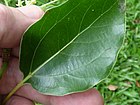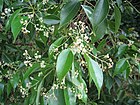Note: This is a project under development. The articles on this wiki are just being initiated and broadly incomplete. You can Help creating new pages.
Cinnamomum camphora - Karpura
Karpura, Cinnamomum camphora is a relatively fast-growing, evergreen tree with a dense crown; it usually grows from 10 - 15 metres tall, but can reach 40 metres. The bole, which usually branches from quite low down, can be up to 75cm in diameter. The plant is grown commercially in China and Japan as a medicinal tree and also for its essential oil, though most camphor oil on the market nowadays is produced synthetically.
Uses
Parts Used
Chemical Composition
Common names
| Language | Common name |
|---|---|
| Kannada | karpoora, paccakarpura |
| Hindi | kapur |
| Malayalam | cutakkarpuram, karpooram |
| Tamil | pachai karpooram, karpuram |
| Telugu | candramu, gamburam, ghanasaramu, kappuramu, karpuramupacha karpooram |
| Marathi | NA |
| Gujarathi | NA |
| Punjabi | NA |
| Kashmiri | NA |
| Sanskrit | candraprabha, himavaluka, karpurah, gandhadravya |
| English | Camphor tree |
Properties
Reference: Dravya - Substance, Rasa - Taste, Guna - Qualities, Veerya - Potency, Vipaka - Post-digesion effect, Karma - Pharmacological activity, Prabhava - Therepeutics.
Dravya
Rasa
Tikta (Bitter), Katu (Pungent), Madhura (Sweet)
Guna
Laghu (Light), Rooksha (Dry)
Veerya
Sheeta (cold)
Vipaka
Katu (Pungent)
Karma
Pitta, Kapha
Prabhava
Habit
Identification
Leaf
| Kind | Shape | Feature |
|---|---|---|
| Simple | alternate | Leaves spirally arranged, glabrous, chartaceous to sub-coriaceous, ovate-elliptic to elliptic to subovate-elliptic, 1-5 x 3-10 cm, base acute or tapered-cuneate, both surfaces minutely reticulate or above smooth; main nerves slender. Petiole slender, 2-4 cm long. |
Flower
| Type | Size | Color and composition | Stamen | More information |
|---|---|---|---|---|
| Bisexual | axillary panicles | greenish white | Panicles axillary, slender, glabrous, many-flowered, up to 10 cm long with few short branches. Pedicels 1-2 mm, obconical. Tepals ovate, acutish, fleshy, c. 2 mm. Stamens 1.5 mm long; anthers broad; inner anthers truncate, upper cells smaller, latrorse; gland large attached to the basal part of the filament. Staminodes stipitate. Style as long as the ovary with peltate triquetrous stigma. |
Fruit
| Type | Size | Mass | Appearance | Seeds | More information |
|---|---|---|---|---|---|
| A berry | 5-10 mm in diameter | Fruit globose, slightly fleshy, 5-10 mm in diameter, seated on a shallow, thin cup, 3-5 mm in diameter at the apex, 1-2 mm deep, the basal part fleshy, obconical, usually not differentiated from the obconical pedicel, together 5-7 mm long. | {{{6}}} |
Other features
List of Ayurvedic medicine in which the herb is used
Where to get the saplings
Mode of Propagation
How to plant/cultivate
Season to grow
Soil type
Propagation
Commonly seen growing in areas
Photo Gallery
References
External Links
- Ayurvedic Herbs known to be helpful to treat Improves digestive system
- Ayurvedic Herbs known to be helpful to treat Inflammation
- Ayurvedic Herbs known to be helpful to treat Decongestant
- Ayurvedic Herbs known to be helpful to treat Cold and cough
- Ayurvedic Herbs known to be helpful to treat Aphrodisiac
- Ayurvedic Herbs known to be helpful to treat Arthritis
- Herbs with Extract used in medicine
- Herbs with common name in Kannada
- Herbs with common name in Hindi
- Herbs with common name in Malayalam
- Herbs with common name in Tamil
- Herbs with common name in Telugu
- Herbs with common name in Sanskrit
- Herbs with common name in English
- Habit - Tree
- Index of Plants which can be propagated by Seeds
- Index of Plants which can be propagated by Cuttings
- Herbs that are commonly seen in the region of Tropical area
- Herbs that are commonly seen in the region of Sub tropical area
- Herbs
- Tree




